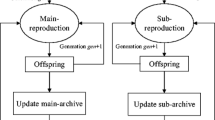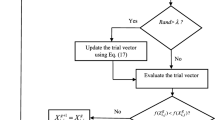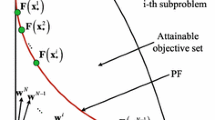Abstract
The operation of a reservoir system for flood resources utilization is a complex problem as it involves many variables, a large number of constraints and multiple objectives. In this paper, a new algorithm named multi-objective cultured evolutionary algorithm based on decomposition (MOCEA/D) is proposed for optimizing the hierarchical flood operation rules (HFORs) with four objectives: upstream flood control, downstream flood control, power generation and navigation. The performance of MOCEA/D is validated through some well-known benchmark problems. On achieving satisfactory performance, MOCEA/D is applied to a case study of HFORs optimization for Three Gorges Project (TGP). The experimental results show that MOCEA/D obtains a uniform non-dominated schemes set. The optimized HFORs can improve the power generation and navigation rate as much as possible under the premise of ensuring flood control safety for small and medium floods (smaller than 1% frequency flood). The obtained results show that MOCEA/D can be a viable alternative for generating multi-objective HFORs for water resources planning and management.





Similar content being viewed by others
References
Baltar AM, Fontane DG (2008) Use of Multiobjective Particle Swarm Optimization in Water Resources Management. J Water Resour Plan Manag 134(3):257–265
Chen L, McPhee J, Yeh WWG (2007) A diversified multiobjective GA for optimizing reservoir rule curves. Adv Water Resour 30(5):1082–1093
Coello CAC, Becerra RL (2004) Efficient evolutionary optimization through the use of a cultural algorithm. Eng Optim 36(2):219–236
Cutter SL, Ismail-Zadeh A, Alcántara-Ayala I, Altan O, Baker DN, Briceño S, Gupta H, Holloway A, Johnston D, McBean GA, Ogawa Y, Paton D, Porio E, Silbereisen RK, Takeuchi K, Valsecchi GB, Vogel C, Wu G (2015) Global risks: Pool knowledge to stem losses from disasters. Nature 522(7556):277–279
Das I, Dennis JE (1998) Normal-boundary intersection: A new method for generating the Pareto surface in nonlinear multicriteria optimization problems. SIAM J Optim 8:631–657
Deb K, Pratap A, Agarwal S, Meyarivan T (2002) A fast and elitist multiobjective genetic algorithm: NSGA-II. IEEE Trans Evol Comput 6(2):182–197
Deb K, Thiele L, Laumanns M, Zitzler E (2005) Scalable Test Problems for Evolutionary Multi-Objective Optimization. In: Abraham A, Jain L, Goldberg R (eds) Evolutionary Multiobjective Optimization. Springer-Verlag, London, pp 105–145
Deb K, Jain H (2014) An Evolutionary Many-Objective Optimization Algorithm Using Reference-Point-Based Nondominated Sorting Approach, Part I: Solving Problems With Box Constraints. IEEE Trans Evol Comput 18:577–601
Ding W, Zhang C, Peng Y, Zeng R, Zhou H, Cai X (2015) An analytical framework for flood water conservation considering forecast uncertainty and acceptable risk. Water Resour Res 51(6):4702–4726
Fonseca CM and Fleming PJ (1993) Genetic algorithms for multiobjective optimization: formulation discussion and generalization. In: Forrest S (ed) Proceedings of the Fifth International Conference on Genetic Algorithms, San Mateo, California, pp 416–423. Morgan Kaufmann
Jia B, Simonovic SP, Zhong P, Yu Z (2016) A Multi-Objective Best Compromise Decision Model for Real-Time Flood Mitigation Operations of Multi-Reservoir System. Water Resour Manag 30(10):3363–3387
Karamouz M, Houck MH (1982) Annual and monthly reservoir operating rules generated by deterministic optimization. Water Resour Res 18(5):1337–1344
Landa Becerra R, Coello CAC (2006) Cultured differential evolution for constrained optimization. Comput Method Appl M 195(33–36):4303–4322
Liu Y, Ye L, Qin H, Hong X, Ye J, Yin X (2018) Monthly streamflow forecasting based on hidden Markov model and Gaussian Mixture Regression. J Hydrol 561:146–159
Marien JL, Damázio JM, Costa FS (1994) Building flood control rule curves for multipurpose multireservoir systems using controllability conditions. Water Resour Res 30(4):1135–1144
Needham JT, Watkins DW, Lund JR, Nanda SK (2000) Linear Programming for Flood Control in the Iowa and Des Moines Rivers. J Water Resour Plan Manag 126(3):118–127
Qin H, Zhou J, Lu Y, Li Y, Zhang Y (2010) Multi-objective Cultured Differential Evolution for Generating Optimal Trade-offs in Reservoir Flood Control Operation. Water Resour Manag 24(11):2611–2632
Reddy MJ, Kumar DN (2006) Optimal Reservoir Operation Using Multi-Objective Evolutionary Algorithm. Water Resour Manag 20(6):861–878
Renfrew A. C (1994) “Dynamic Modeling in Archaeology: What, When, and Where?” Dynamical Modeling and the Study of Change in Archaeology, S. E. van der Leeuw, ed., Edinburgh University Press
Reynolds RG (1994) An Introduction to Cultural Algorithms. In: Sebalk AVF (ed) Proceedings of the 3th annual conference on evolution programming. World Scientific, River Edge, pp 131–136
Storn R, Price K (1997) Differential evolution - A simple and efficient heuristic for global optimization over continuous spaces. J Glob Optim 11(4):341–359
Wei C, Hsu N (2009) Optimal tree-based release rules for real-time flood control operations on a multipurpose multireservoir system. J Hydrol 365(3–4):213–224
Yeh WWG (1985) Reservoir Management and Operations Models: A State-of-the-Art Review. Water Resour Res 21(12):1797–1818
Zhang J, Liu P, Wang H, Lei X, Zhou Y (2015) A Bayesian model averaging method for the derivation of reservoir operating rules. J Hydrol 528:276–285
Zhang Q, Li H (2007) MOEA/D: A Multiobjective Evolutionary Algorithm Based on Decomposition. IEEE Trans Evol Comput 11(6):721–731
Zhou Y, Guo S, Xu C, Liu P, Qin H (2015) Deriving joint optimal refill rules for cascade reservoirs with multi-objective evaluation. J Hydrol 524:166–181
Zitzler E, Laumanns M, Thiele L (2001) SPEA2: improving the strength Pareto evolutionary algorithm. Paper presented at the Computer Engineering and Networks Laboratory (TIK), Gloriastrasse 35, CH-8092 Zurich, Switzerland
Acknowledgements
This work is supported by the National Natural Science Foundation of China (No. 91647114, No. 51779013, 51479075), the Natural Science Foundation of Hubei Province (2017CFB613), the Fundamental Research Funds for the Central Universities (HUST: 2016YXZD047), and special thanks are given to the anonymous reviewers and editors for their constructive comments.
Author information
Authors and Affiliations
Corresponding author
Ethics declarations
Conflict of Interest
The authors declare that they have no conflict of interest.
Rights and permissions
About this article
Cite this article
Liu, Y., Qin, H., Mo, L. et al. Hierarchical Flood Operation Rules Optimization Using Multi-Objective Cultured Evolutionary Algorithm Based on Decomposition. Water Resour Manage 33, 337–354 (2019). https://doi.org/10.1007/s11269-018-2105-3
Received:
Accepted:
Published:
Issue Date:
DOI: https://doi.org/10.1007/s11269-018-2105-3




